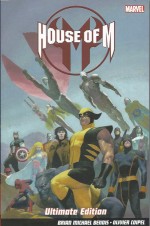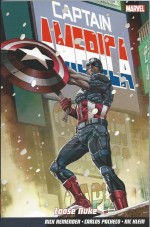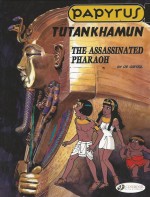
By Dan Slott, Christos N. Gage, Humberto Ramos & Victor Olazaba, Javier Rodriguez & Ãlvaro López and various (Marvel/Panini UK)
ISBN: 978-1-84653-584-0
With this superb reinterpretation of the Amazing Arachnid iteration clearly approaching an ending or final resolution, the tension in this sublime series is again ratcheted up by scripter Dan Slott in The Superior Venom which collects issues #22-25 of Superior Spider-Man (4th September-13th November 2013) and Superior Spider-Man Annual #1.
Where Were You When…?: in an apocalyptic final battle Peter Parker apparently died and Doctor Otto Octavius took over his body. The hero’s mind had been imprisoned in the dying body of the super-villain where, despite his every desperate effort, at last Peter perished with and within that decrepit, expiring frame.
This left the coldly calculating Octopus permanently installed in the Wondrous Wallcrawler’s body and successfully living out Parker’s life, albeit with a few minor but necessary alterations, upgrades and improvements…
At first the situation did not seem utterly hopeless. As his foe exulted in triumph, Parker had inflicted his full unvarnished memories on the psychic invader, forcing unwary Otto to experience every ghastly moment of tragedy and sacrifice which combined to make Spider-Man the compulsive do-gooder that he was.
From that enforced emotional turmoil came a bitter understanding. Ock had a change of heart and swore to live the rest of his stolen life in tribute to his greatest enemy; earnestly endeavouring to carry on Spider-Man’s self-imposed mission, guided by Peter’s abiding principle: “with great power comes great responsibilityâ€â€¦
However Octavius’ ingrained monomania proved impossible to suppress and the usurper constantly toiled to prove himself the better man: augmenting Parker’s paltry gadgets and slapdash methodology with millions of spy robots to patrol the entire city at once, constantly adding advanced tech and refining new weaponry to the suit and even acting pre-emptively rather than merely reacting to crises as the original had…
Otto even took Parker’s frame back to college because he arrogantly refused to live life without a doctorate and even briefly tried to rekindle his new body’s old relationship with Mary Jane Watson.
The new, ultra-efficient Spider-Man became New York’s darling and even Mayor J. Jonah Jameson embraced the Web-spinner; practically adopting Spider-Man as his deputy – to the utter incredulity of an imperceptible psychic fragment of Peter which still screamed in frustration within the deepest recesses of the hero’s overwritten consciousness…
The helpless ghost was an unwilling passenger, unsuspected by Octavius yet increasingly privy to the villain’s own barely-suppressed memories. Simultaneously, more and more of Parker’s oldest friends began to suspect something amiss…
Police CSI Officer and ex-girlfriend Carlie Cooper knew Peter’s secret identity and recalled the last time Spidey fought Doc Ock, when the killer broke her arm. He claimed then that he was Peter trapped in the villain’s body…
The public initially seemed happy with how Spider-Man had changed. Not only was he more efficient, but far more brutal too. This new hard-line attitude actually increased the webslinger’s approval rating and, following a hostage siege, his status peaked after he executed the psychotic perpetrator Massacre…
Eventually Octavius realised there was a noble passenger in his head and eradicated the last vestiges of his enemy’s presence – at the cost of many of Parker’s useful memories – but the trade-off was a fully liberated mind able to make darker decisions whilst instigating his revolution in crime-fighting.
Helping Jameson after Spider-Slayer and other super-felons rioted on The Raft, the hero blackmailed the Mayor into donating the now empty edifice as a base of operations. The superior wallcrawler designed a new costume, built giant Arachnaut war-tanks and even hired a gang of henchmen to help him clean up the city for the decent, law-abiding citizens.
Despite winnowing “Parker’s†personal life to a less distracting level, Ock still wanted that elusive doctorate and whilst negotiating the petty bureaucracy of Academia Parker began a romance with brilliant Anna Maria Marconi …
From his transformed citadel on the now-renamed Spider Island II, Spider-Man watches over his city through the electronic eyes of thousands of tiny Spider-bots, keeping a special lookout for resurgent hidden criminal mastermind Goblin King (an updated and even crazier Green Goblin Norman Osborn) who was slowly completing his own campaign to take over the underworld with his Goblin Army Cult.
To that end the emerald maniac transformed young Phil Urich – latest iteration of The Hobgoblin – into a Goblin Knight to lead his armies to inevitable victory…
Meanwhile, Carlie shared her suspicions about Spider-Man with friend and Police Captain Yuri Watanabe (who secretly moonlights as costumed vigilante The Wraith) and together they set about gathering definitive proofs of their suspicions regarding the Wallcrawler.
Since Spidey now has an Island fortress and a mercenary gang to pay for, they even had a money trail to follow…
However Carlie’s investigations alerted all the wrong people and she was abducted by the Goblin Army…
This rocket-paced chronicle opens with ‘Hostage Crisis’ from Superior Spider-Man Annual #1, scripted by Christos N. Gage and illustrated by Javier Rodriguez & Ãlvaro López, which sees potential disaster stemming from the leaked (cover) story that Peter Parker is the technical wizard building all the Superior Spider-Man’s gadgets.
The secretly embedded hero/villain is just starting to repair his relationship with Aunt May and her wealthy husband (J. Jonah’s dad Jay Jameson): helplessly re-experiencing the lad’s abiding affection for the gracious old lady when vampiric villain Blackout kidnaps her.
The darkness-generating undead psychopath has got wind of the Parker connection and wants Peter to sabotage Spider-Man’s gadgets, but he has not reckoned on the insane degree of sadistic violence the new hardline Superior Wallcrawler might inflict on anyone threatening those under his protection…
Sadly for the increasingly complacent Octavius, he is equally unaware that May is a witness to the ferocious punishment beating the Webslinger delivers. Thus, even though the upshot of the rescue is that the Parker clan is categorically “off-limits†to every rational denizen in the criminal fraternity, May now wants Peter to sever all ties to the monstrous Spider-Man…
And even more disturbing, nobody ever accused the Green Goblin of rationality…
Over in Superior Spider-Man the 4-part saga ‘Darkest Hours’ commences with ‘Beginnings’ as Betty Brant investigates a new Crime Master, terrified that he may be her wayward brother Bennet when old boyfriend Eugene “Flash†Thompson intervenes.
He still has feelings for the plucky journalist and is prepared to risk his top-secret, covert US operative job for her…
Once upon a time Spider-Man spawned an implacable enemy called Venom: a deranged and disgraced reporter named Eddie Brock who bonded with Parker’s alternate costume: a semi-sentient alien parasite called the Symbiote which the wallcrawler first picked up during Secret Wars.
Brock became a savage, shape-changing, dark-side version of the Wallcrawler, but after numerous spectacular clashes, the arachnid adversaries eventually reached a brooding détente and Venom became a “Lethal Protectorâ€, dispensing a highly individualistic brand of justice everywhere but New York City.
Since thenmany other hosts have bonded with the ebony parasite, including Brock’s wife Ann Weying, Mac Gargan AKA the Scorpion, mobster Angelo Fortunato, Mayoral assistant Edward Saks and even Franklin Richards and members of the Fantastic Four.
Eventually the Government took control of the Symbiote and offered it – with strings attached – to Flash: Spider-Man’s greatest fan and a war-hero who came back from Afghanistan without his legs.
A recovering alcoholic, Eugene became the star of a military black-ops operation which uses the Symbiote to carry out under-the-radar missions vital to US security.
In return, Thompson gets to be a hero (of sorts), feel useful again, serve his country and get out of his wheelchair prison for 48 hours at a time. Agent Venom even became a Secret Avenger, serving directly under Steve Rogers.
Of course there were drawbacks: the parasite is a voracious deadly menace, constantly seeking to permanently bond to its wearer, and is classed as one of the most dangerous entities on the planet. If the new Venom should go berserk, or if the human host stays bonded for more than two days, his war-room controllers will simply detonate explosives attached to Thompson’s body and start the project over with another volunteer. It’s what they had to do with the previous wearer, after all…
Now however Flash is risking everything for Betty, infiltrating the gang with his shapeshifting abilities…
Elsewhere his oldest friend Dr. Peter Parker is taking things to a new level by launching his own tech start-up company. Apparently gripped by exuberance – if not monomania – the very proud owner of Parker Industries is showing around his major investors, May and Jay Jameson, introducing them to medical maverick Elias Wirtham and offering his aunt the gift of a lifetime…
The doughty old lady has lived with chronic pain ever since her leg was injured in a criminal attack, but now Peter has devised a cybernetic implant which will enable her to walk normally again…
In a seedier part of town Captain Watanabe searches for her missing partner Carlie Cooper and comes to the understandable but erroneous conclusion that Spider-Man is responsible for her abrupt disappearance…
As the Spider henchmen continually scan the city for signs of the Goblin Gang they notice Venom battling Crime Master’s gang and alert their boss. Soon the entirety of the Spider force is tracking what they perceive as one of the most dangerous entities on the planet…
In ‘Complications’ the spectacular clash results in Flash’s defeat, but the new Spider-Man has no recent memory of Parker’s school days bully so when Venom escapes the Wallcrawler sets off in relentless, obsessive pursuit.
Deep in a hidden place Carlie is suffering at the hands of the Green Goblin who is desperate to glean all she knows about Spider-Man (information the troubled Osborn has himself forgotten)…
Eager to introduce May and Jay to new significant other Anna Maria, “Peter†arranges a dinner party at his apartment, but the preparations are interrupted when wheelchair-bound Flash turns up, looking to his old friend for shelter…
Another plot strand begins in the Mayor’s office where Jonah Jameson, fed up with Spider-Man’s exploitative extortion, commissions shady genius Tyler Stone of Alchemax to build a new generation of Spider-Slayer robots to protect the city.
The unscrupulous technologist is happy to turn the project over to his new protégé Michael O’Mara who unbeknownst to any is the temporally stranded Spider-Man of 2099…
The dinner party is a disaster. Peter is obsessively concentrating on Flash and doesn’t realise how disturbed old-fashioned May is that the prospective mother of the next generation of Parkers is a “little personâ€. After all, he never once mentioned Anna Marie’s dwarfism…
Too furious and impatient to play it cautiously, Peter shrugs off all the nonsensical emotionalism, concentrating on tricking Thompson – and the precious Symbiote – into his labs with the lure of fully responsive cybernetic legs…
The bait works and soon Spider-Man joins Dr. Wirtham (who moonlights as Robin Hood bandit Cardiac) in overseeing a procedure whose real purpose is to separate the man from the Symbiote.
It all goes horrifically awry and the ghastly invader attaches itself to the Wallcrawler, consequently reawakening the very worst instincts of the insane old Doctor Octopus and the fanatical, amalgamated defender of the weak becomes a sinisterly new horror: ‘The Superior Venom’…
As the diabolically driven creature goes on a crimebusting rampage, treating muggers, murders and litterbugs with equal savagery, the Green Goblin declares war on his rival (and cheap knock-off) Roderick Kingsley who has been franchising super-villain gigs as the Hobgoblin.
On a roll and finally losing patience with his cop captive, Osborn doses Carlie with mutagenic chemicals to transform her into one of his faithful acolytes. The forcibly crazed new Monster seems delighted to join his vile viridian family…
The Parker clan’s troubles also peak when Mary Jane Watson attempts to broker a peace between May and Peter and only succeeds in forcing her ex to terrifyingly transform into Venom before everybody’s appalled eyes. Luckily Yuri arrives to drive him off, giving MJ time to call in the Avengers to take down the out of control über-symbiote…
In ‘Conclusion’, with the city being devastated by the alien horror Flash – unable to survive without the ravening parasite – manages to trick the beast back into his body, seemingly giving the now coolly rational Octavius a golden opportunity to claim all his recent aberrant violent behaviour was caused by previous exposures to the creature.
…But whilst Parker’s friends and family are prepared to accept that line, ever-suspicious Iron Man has secured proof that the Superior Spider-Man has been lying from the very start…
Worst of all, the possession of Otto by the beast has awaked an aggravating ghost in his head he had thought long dead……
To Be Continued…
This carnage-crammed chronicle includes a covers-&-variants gallery by J.G. Jones, J. Scott Campbell, Humberto Ramos, Skottie Young, Stefano Caselli & Frank Kozik and more up-to-the minute AR icon sections (Marvel Augmented Reality App pages which provide access to story bonuses and content on your smart-phone or Android-enabled tablet).
Spider-Man has been reinvented so often it’s almost become commonplace, but this iteration – for however long it lasts – is one no lover of relentless action and diabolically devious drama should miss: clever, cunning, shocking and completely addictive.
™ & © 2013 and 2014 Marvel & Subs. Licensed by Marvel Characters B.V. through Panini S.p.A. All rights reserved. A British Edition published by Panini Publishing, a division of Panini UK, Ltd.












